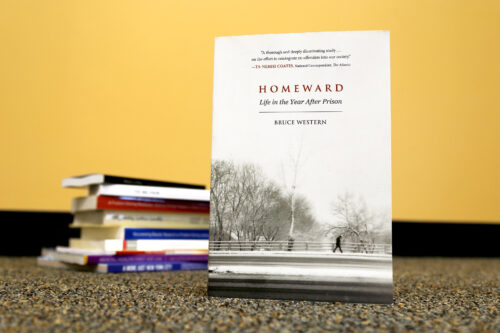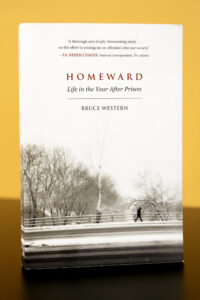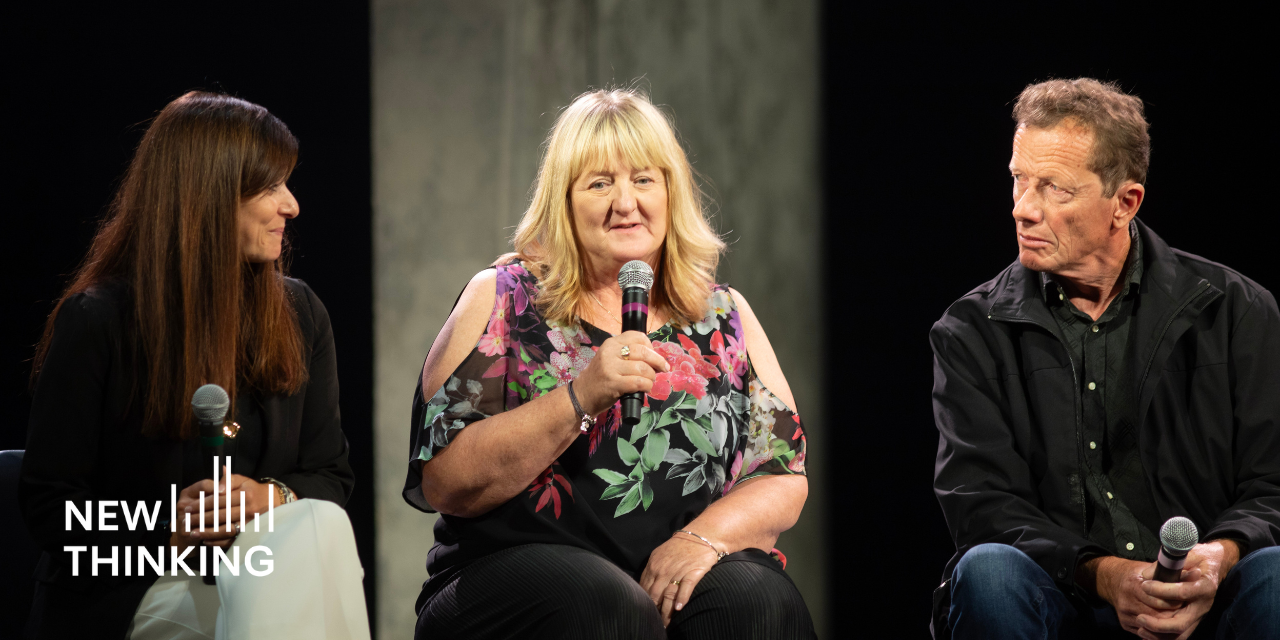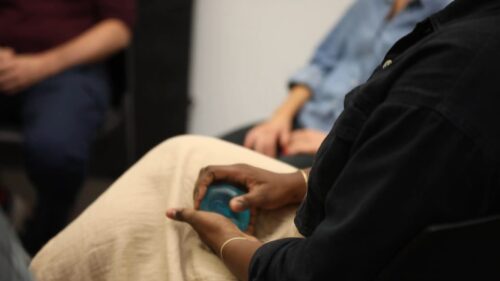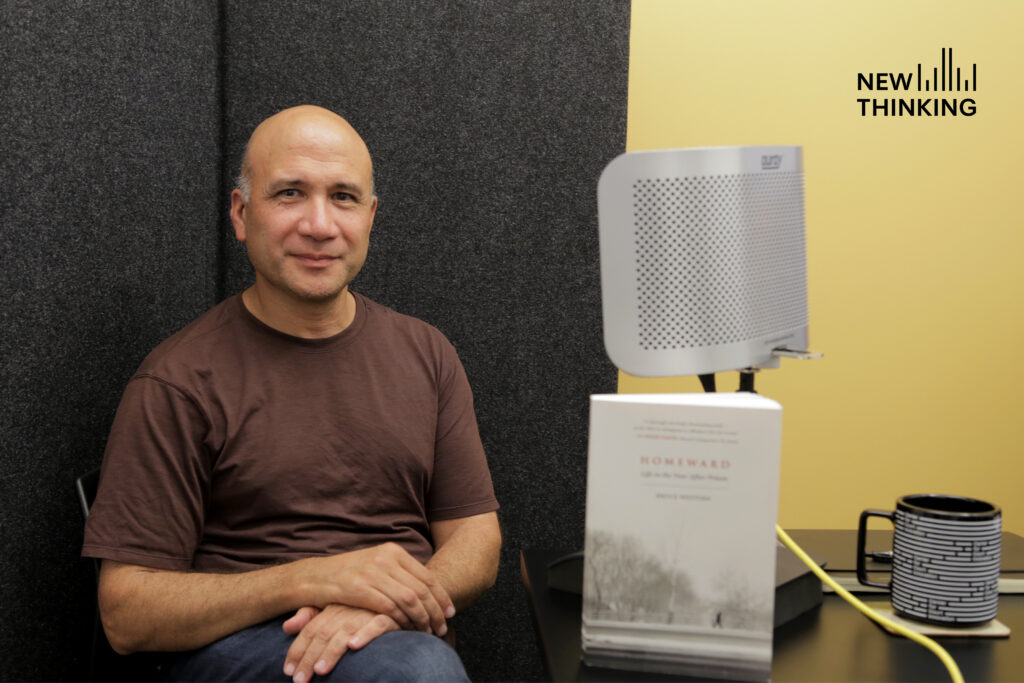
The criminal justice system as it exists now is historically punitive. We’re punishing people who themselves have experienced a great deal of victimization.
“Life in the Year After Prison.” That’s the subtitle of Bruce Western’s new book, Homeward, based on an intensive year-long study of people returning after incarceration to neighborhoods in the Boston area. But zeroing in on that one difficult year also means talking about people’s lives in the years that led to prison—years generally of deep deprivation, instability, and often violence. It also means grappling with the uniquely American phenomenon of mass incarceration. How incarceration swelled into the default response to a host of complex and persistent social problems, and how, as a response, it makes almost every problem it touches worse.
A professor of sociology at Columbia University and a leading expert on the connection between mass incarceration and poverty, Western’s focus leads him to plea for a justice system concerned less with dividing the guilty from the innocent and more with treating everyone with compassion and respect. As he explains in this conversation with New Thinking host Matt Watkins: “We think about incarceration as a deprivation of liberty. A different, but related, way of thinking about it is as a disruption and distortion of human relationships.”
The following is a transcript of the podcast:
MATT WATKINS: I thought we’d just start by talking briefly about the study that’s at the center of the book, so people get a sense of what you were doing and the mechanics of it. That is the Boston reentry study.
BRUCE WESTERN: The Boston reentry study was motivated by a lot of research I’d been doing over the past 15 years or so, trying to understand the consequences of incarceration, how people do in the labor market with their families, with their health and so on, after they’ve been in prison. I was analyzing big data sets and I was concerned that the kinds of empirical material I was working with wasn’t really providing me with a very granular understanding of the whole social process of this transition from prison back into the community.
I thought I really needed to try and get into the field and get close to the problem, speak to people who were making this transition from incarceration to community. The idea of the study was to begin interviewing people one week before they’re released from prison and then follow them over the year after release as they went back into the community.
We had a sample of 122 people. The only criterion for eligibility was that you were returning to a neighborhood in the Boston area. We interviewed men and women—we’re in minimum security prisons, we’re in maximum security, we’re in solitary confinement units, talking to people behind plexiglass in non-contact units. Then we would meet with them two weeks later after prison, back on the outside in the community. And we followed their lives over the following year.
WATKINS: Are there generalizations that you can make about this population as a whole in terms of life history, experiences?
WESTERN: Yeah, some things were very striking to us. Nearly everyone we interviewed grew up poor. Although the study was covering the entire Boston area, we’re really in a handful of neighborhoods. The footprint of the criminal justice system falls overwhelmingly in very poor communities of color. In many cases there was a history of exposure to violence and trauma that I have to say we weren’t fully anticipating going into the data collection.
People were struggling in different ways with mental illness and drug addiction. They were the real threads. They were the biographies that people were bringing to this process of reentry, of this transition from prison to community.
WATKINS: You have this concept I was struck by of human frailty, which really seems to be where we get into what is the ethical concern of the book, because you’ve spoken about wanting to have a more granular understanding of people’s lives. Could you explain a bit more about what you mean by this concept and how it plays into people becoming involved with the criminal justice system and incarcerated?
WESTERN: The idea of human frailty, I guess, at some level is an elaboration of the idea of poverty: how we think about very deep material hardship. When people like me, sociologists, talk about poverty it’s narrowly an income concept.
But what we were seeing was that people who were growing up in poverty with very low incomes were also dealing with a host of other problems that included things like growing up in a very chaotic home life, which exposed people to the risk of victimization, witnessing a lot of violence in their childhood. People grew up with poor health and poor mental health. Family members were also struggling with those problems, and a lot of housing insecurity, also in childhood that sustained over the life course.
So human frailty for me was a cluster of disadvantages, a cluster of adversities, some of which took a very bodily form. This added to the insult of poverty. It put people at risk of contact with the criminal justice system…
WATKINS: …which then exacerbates these problems…
WESTERN: …and which exacerbates these problems and it makes the process of reentry and finding your place in the community again after incarceration that much more difficult.
WATKINS: Did you anticipate when you started work on this project that it would, in my reading, expand into something that’s actually quite a bit bigger than just looking at this one year after prison? Did you initially imagine that it would be a much more contained argument, in some senses?
WESTERN: Because of the type of research I had done in the past and the kinds of data I was looking at, I think I had a fairly simplistic idea of the kinds of things people were struggling with, before they went into prison and then after they got out. They were things like having really low-level schooling. In many cases having dropped out of school. Often living in a poor neighborhood and in many cases racially-segregated neighborhoods, so where poverty was very concentrated.
As we got to know people and as they opened up to us about their lives, we were hearing a lot more than that. We were hearing about trauma and violence, about addiction, about mental illness—much of which went untreated for long periods of time and suffused family networks. I think it gave me a much richer understanding of the very harsh conditions of American poverty in which the safety net is very thin and provides very little support to poor people.
WATKINS: In a sense this portrait that you’re offering is making how we think about criminal offenses much more complex. You’re really complicating the simple binary between good and evil, guilty and innocent.
If we look for a moment specifically at the question of violence and people experiencing and witnessing violence in their early years, I was really struck by the statistic of 40 percent of people in your survey had witnessed someone being killed. That’s just an extraordinary number. How do you think your findings complicate how we think about people who have been convicted of violent offenses?
WESTERN: I mean for me this was one of the really eye-opening aspects of the research. I felt through this work we had gained some window onto a world that was just shot through with ethical ambiguity. Because of the different kinds of material hardship the people were dealing with, they’re very often put in situations where they had to make choices that in many cases those choices were never very good. Violence in some cases became functional, became a way of dealing with problems, very difficult problems.
I think this is very different from the moral universe that is contemplated by our criminal justice system, which tends to divide the world into innocent victims and guilty offenders. Guilty offenders prey on innocent victims, and the job of the system is to mete out punishment and separate offenders from victims.
But in the world of the Boston reentry study that our respondents were sharing with us, you couldn’t divide the world into victims and offenders because people who in some cases committed acts of serious violence, for example, and had gone to prison for them, had very serious histories of victimization themselves, and had witnessed a lot of violence themselves. I think the violence we observed in many cases was of a very contextual kind, which meant that people were growing up in chaotic homes. They were living in neighborhoods that were very high crime areas.
It makes me think if you had grown up in that family, or if I had grown up in that family, we would have been exposed to a lot of violence in our lives too, and we may well have become quite seriously involved in violence as well.
WATKINS: But what would a criminal justice system look like that was designed to respond to the kind of trauma that you’re talking about? Obviously, as you acknowledge, the system as it’s built up now is certainly not built to respond to complexity. I’m wondering what you would say to a skeptic who might say, “Hey, that’s just not the lane of the criminal justice system. It’s about public safety. It’s about accountability.”
WESTERN: For me, there are two big implications. One is I think we have to take really seriously the life histories of trauma that people have experienced. We have to understand the ways in which that might affect their decision making, their time horizons and things like that. We have to adapt our programming to be trauma-informed as the experts say. So that’s one piece of it. I think we’re not very far down that road.
The other piece of it goes to jurisprudence, how we think about punishment in our criminal justice system. I think if we take on the histories of victimization, the exposure to violence over a lifetime, of people who are in the state prison, I think it opens the door to greater leniency and compassion. It’s challenging. It’s difficult to take account of moral complexity. But I think we can think about how these kinds of very difficult life histories can be mitigating in punishment.
The criminal justice system as it exists now is very, very punitive. Historically punitive. We’re punishing people who themselves have experienced a great deal of victimization. I think we need to take stock of that ethically.
WATKINS: As we move in this discussion somewhat chronologically towards this reentry year—the year after prison—could we talk a little bit about what you found was the effect of prison itself on your respondents? We’re speaking today in the midst of a quite remarkable national prison strike, one calling for, among other demands, an end to death by incarceration. What do we learn about the experience of prison by focusing on the difficulty of reentry?
WESTERN: I think we can think about incarceration in two distinct but related ways. We often think about incarceration, and certainly the justice system does, as a deprivation of liberty. But a different, but related, way, of thinking about incarceration is as a disruption and distortion of human relationships. When people are removed from their communities, removed from their families, there’s going to come a point when they’re released when they’re going to have to reestablish all of those social connections again.
It’s a very unusual social process. It doesn’t have many parallels because it also carries the baggage of a criminal sentence—the stigma of a criminal record. So, at a very, very fundamental level: what’s the effect of prison? The effect of prison is the creation of this problem of having to return, having to reestablish, and find one’s place in society again.
I could say a lot more about what people experienced in prison. A lot of the prisons that we went into were disorderly. People felt unsafe. There was fighting. There was drug use. Programming was often in short supply. People had unmet health needs, unmet mental health needs. A lot of people reported to us anxiety, depression, PTSD, as a consequence of their incarceration. All of which creates obstacles to returning to communities.
WATKINS: If we now focus on this transition year—this year after prison—and your portrayal of prison itself as being a community-eroding institution, something that takes away already often fragile social ties and community bonds, which are so vital to people’s social lives. What are the primary obstacles to people’s year of reentry? And then what were the markers of success?
WESTERN: Three primary obstacles really stood out to us: income, housing, and health. People have very, very low incomes—$6,000 on average in the first year after incarceration. That’s about half the federal poverty line for an individual living alone. There was a lot of material hardship that accompanies those very low incomes.
Housing was an enormous challenge in the first year after incarceration. There was no independent housing at all that we observed across the entire sample in the first year after prison. That meant that people were either doubling up with families, which was mostly mothers and grandmothers and aunts and older sisters. So the older women in people’s lives. Most were doubling up or they were in some sort of transitional housing. And some were street homeless. So housing was an enormous problem.
I think one of the policy challenges is not so much supplying more housing for prime-age single men who were coming out of prison, but trying to find ways to support the households that these men are often returning to. We found there were lots of positive effects of living in a household. So even if you’re doubling up in your mother’s house, there were all sorts of positive effects of being in a private household as opposed to a shelter, say.
And then the third thing, people struggled a lot with their health.
WATKINS: Back to this human frailty question.
WESTERN: Exactly. And there’s a clear empirical connection in the data between histories of exposure to violence and trauma in childhood and poor heath in adulthood. Partly this meant a lot of mental illness, a high rate of mood disorders, like depression and anxiety, and some serious mental illness: psychoses, bipolar disorder. And physical disability—people were in poor physical health. So, there was a high rate of chronic pain in the sample. Some of it was related to drug use. Arthritis and back pain. A lot of diseases of poverty: diabetes, asthma, things like that. Chronic conditions which people had to manage in an ongoing way in addition to everything else you have to do when you come out of prison and try and make a home in a community.
WATKINS: Are there some generalizations we can make about people who had more successful reentries, and of what were the markers of people doing better in terms of community ties and reintegrating?
WESTERN: Although the picture I’m painting is very challenging, some people did really well. I think family support was very important, particularly for housing. Families were an enormous support. Employment as well was a real marker of success. The unemployment rate across the year was about 50 percent. In any given month about half the sample had not done any work. More than just employment, skilled employment in particular was really important for people doing well…
WATKINS: But very hard to attain.
WESTERN: There was a small group of white men who got union jobs in the construction industry. There are union hiring halls in Boston, so that lifted them over the hurdle of the criminal background check in hiring. They had skills, they had training, and they were well paid.
In some ways that to me is what successful reentry should look like. If people are able-bodied, and can be given skilled work that pays well, significantly above the minimum wage, and most of the employment we observed was at the minimum wage, but if people can live significantly above the minimum wage, then they can be out of poverty. They can support a household. They can pay taxes. The union guys got retirement benefits, which I think allowed them to look to a future. Most of the rest of the sample in that first year were in survival mode.
WATKINS: If you have support from an institution, say, a union, or obviously if you have support from family—not just the stability of housing, but the stability of social ties in general—it seems like those were markers of someone having a more successful reentry. I think you found people who were greeted at the prison upon their release by family members tended to do better than people who weren’t.
WESTERN: This was also a bit of a revelation in the research—a lot of people in the first week or so were telling us about welcome home parties. We sort of got very interested in what happens on the first day out, the second day out; if someone’s throwing a party celebrating your return. And for people who were very socially isolated in that first week—so they weren’t meeting with relatives, they weren’t actively engaged—they tended to do worse six months later if they’re very socially isolated immediately after they came out of prison.
WATKINS: We’ve touched on this issue of race a little bit, speaking about these older, generally white union workers who tended to fare better. But when you’re writing about this huge social institution of mass incarceration more generally you say that you see this as a driver of a new kind of racial inequality. I wonder why it’s important for you to say that it’s a “new” kind of racial inequality? Obviously it’s building upon a much longer one—that’s constitutive, arguably of this country—but how did you find reentry challenges played out differently by race?
WESTERN: The really striking finding for us was in the labor market. There was a very large employment gap between white respondents and black and Latino respondents. The white men that we were interviewing did significantly better in employment than the black and Latino respondents—even though they tended to be older, they tended to be in poorer health, they had a higher rate of mental illness and drug addiction. Despite all of those disadvantages, they were financially much more secure and independent after incarceration.
There were racial differences in the sample. That people’s pathway into prison was different. For the black and Latino respondents, they tended to be younger. They tended to have had problems at school. They tended to have dropped out of school. It seemed to us that incarceration in their case was very much the product of blocked economic opportunities, very limited economic opportunities in the communities in which they were growing up.
The white men we were interviewing, they tended to be older, they had long histories of drug addiction and mental illness. In their case this looked much more like the product of a public health crisis among low-income white men. And of course, overlaid on all of this there’s a very large racial disparity in incarceration.
I think disadvantage, socioeconomic disadvantage, is playing out in a new way in this era of a very high incarceration rate, which has been with us now for a generation. Why is it important to say that this is new? Because I think we’re dealing with a post-civil rights reality. We’re in a world in which discrimination and racial discrimination in public accommodations, in the labor market, in housing markets, in credit markets, is now illegal. There were strong expectations that anti-discrimination protections would open up full citizenship to African Americans, and they could join the structure of mainstream opportunities of the rest of American society. And it didn’t happen.
Why did all of these anti-discrimination protections not open up the full spectrum of opportunities to African Americans? Shortly after the passage of the civil rights act in the 60s, the criminal justice system turned in a much more punitive direction, and prison populations began to grow. The civil rights acts were succeeded by an era of mass incarceration, which was facially color-blind—you didn’t have statutes that prosecuted blacks and whites differently in the black letter of the law. But the effect of the punitive turn in criminal justice policy had massively racial disparate effects.
Within a generation, among African-American men who dropped out of high school, about two-thirds of them wound up in state or federal prisons.
WATKINS: Turning to look at women and their experiences in prison, and the difficulties of reentry, there weren’t many women in your study, and you can talk about the reason for that, but you write that “the experience of women throws the injustice of incarceration into its sharpest relief.”
WESTERN: There were 15 women in our sample of 122. As we got to know them over the course of the year, they shared with us very, very serious histories of victimization. They struggled mightily in nearly all cases with mental illness and addiction. The problems that they were facing, which was a significant part of their path into prison in the first place, the challenges that they were facing, were much more serious than we saw among the men. The histories of victimization were so striking to us, and in most cases began in early childhood and were sustained over a lifetime.
None of the women we interviewed had been convicted of serious violence. That was confined to the men in the sample. That mirrors patterns in national statistics. Earlier we were talking about the ethical complexities of the social world of people who go to prison. I think those complexities are most serious for women. The criminal justice system fiction that divides the world into good people and bad people, innocent and guilty, victims and offenders—that world completely dissolves when we think about the women in state prison.
WATKINS: I wanted to end actually with this question, the kind of ethical concern that I think runs right through the book, which is captured in the title of the last chapter: “criminal justice as social justice.”
I guess it’s a huge question, but if you could unpack a little bit here, what you mean by this notion of “criminal justice as social justice,” and again bearing in mind the skeptic who might say, “Look, you’re asking the criminal justice system to do too much. It should have a more limited role.”
WESTERN: The incarceration that we learned about, and the biographies of the people who were incarcerated, were intimately connected to three social conditions at the bottom of the social hierarchy of American life. One is deep poverty, and poverty doesn’t just mean low-income. It’s coupled to all the challenges of human frailty. One is deep racial inequality, so in many, many cases we’re talking about very disadvantaged communities of color. The third thing is the violence that arises in these contexts of racial inequality and deep poverty.
We have responded to those social conditions with a very harsh regime of punishment that’s created the largest penal system in the world. How do we retreat from it? How do we reverse mass incarceration? Well, we should shrink the system. Will that be enough? Will that speak to the harsh conditions of poverty that we observed through the criminal justice system? Just shrinking the system, will that make those communities flourishing and healthy and give people opportunities that are widely enjoyed by the mainstream of American society?
I don’t think it’s enough to shrink the system. I think we need to be thinking of ways of how people can be reintegrated into the social compact in the aftermath of harm and violence.
What does that imply for policy? I think it means there has to be a role for things like improving people’s economic opportunities, their educational opportunities, making their housing more secure, making their family life more secure. All of that contributes to the safety of communities and helps reintegrate people in the aftermath of violence.
Is this beyond the jurisdiction of the criminal justice system? I wonder if we should be redefining our terms. I wonder if we should be thinking about not a criminal justice system, but a justice system. What set of institutions can help promote fairness, human flourishing, social cohesion, a rich community life in American society? Some of those institutions will look something like traditional criminal justice agencies, but some of those institutions will look very different I think.
WATKINS: This is what you mean by creating a thick public safety, as opposed to a sort of thin public safety that we arguably have now, which is created by this culture of punishment?
WESTERN: We look at safe and flourishing communities and why they’re safe and flourishing. Is it because there is a vigilant police force that is maintaining order on every street corner and meting out harsh punishment to all sorts of deviants? That’s not what makes flourishing communities safe. What makes them safe is a rich institutional life, order and predictability in daily life that’s provided through employment, and families, and community organization. I think we have to develop ways of building all of those social community bonds that provide order and predictability in daily life, allow communities to flourish.
The tool of punishment, fundamentally I think, is corrosive of that project. It destabilizes social bonds. So retreating from mass incarceration will involve building a very different set of supportive institutions.
WATKINS: Well, Bruce, I want to thank you very much for your book, first of all, which I just found enormously thought-provoking. Then, of course, thank you very much for being here today.
WESTERN: Thanks for this conversation, Matt.
WATKINS: I’ve been speaking with Bruce Western. Bruce is a professor of sociology at Columbia University, and the co-director of its Justice Lab. He’s also the author of the book from the Russel Sage Foundation we’ve been discussing today, Homeward: Life in the Year After Prison
If you enjoyed this episode, you might want to scroll back in our feed a bit to listen to the recent discussion I had with another sociologist, Patrick Sharkey at New York University. We talk a lot in a similar vein about the wider effects of violence and the real meaning of public safety.
Technical support today provided by the inimitable Bill Harkins. And our theme music is by Michael Aharon at quiver NYC. For more on today’s episode and all of work visit our website, courtinnovation.org/newthinking.
This has been another episode of New Thinking from the Center for Court Innovation. I’m Matt Watkins. Thanks for listening.

